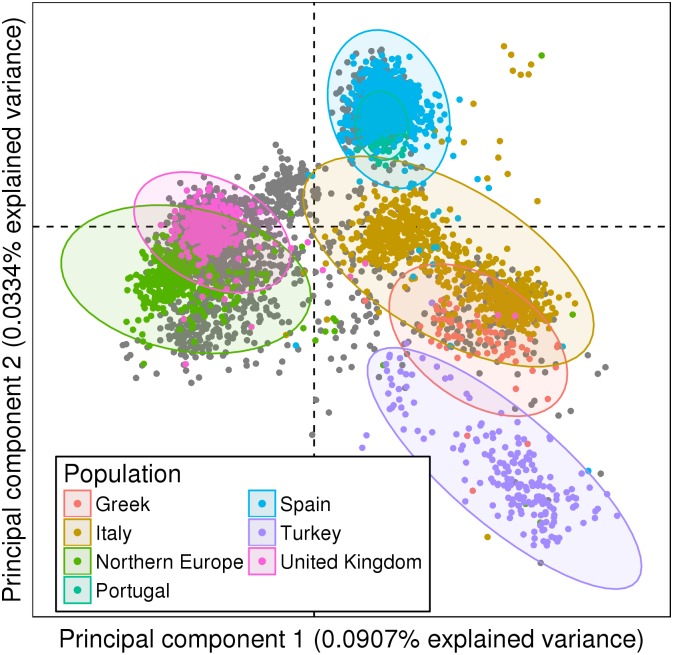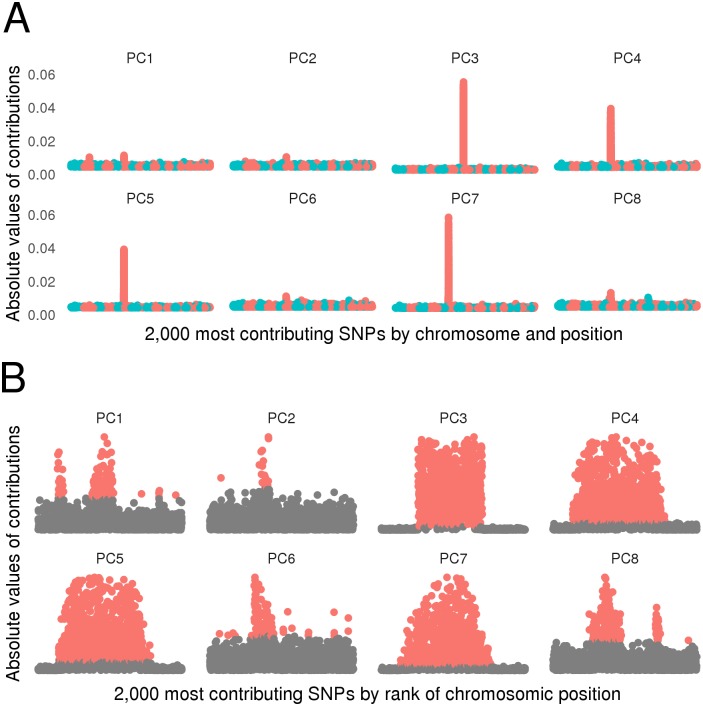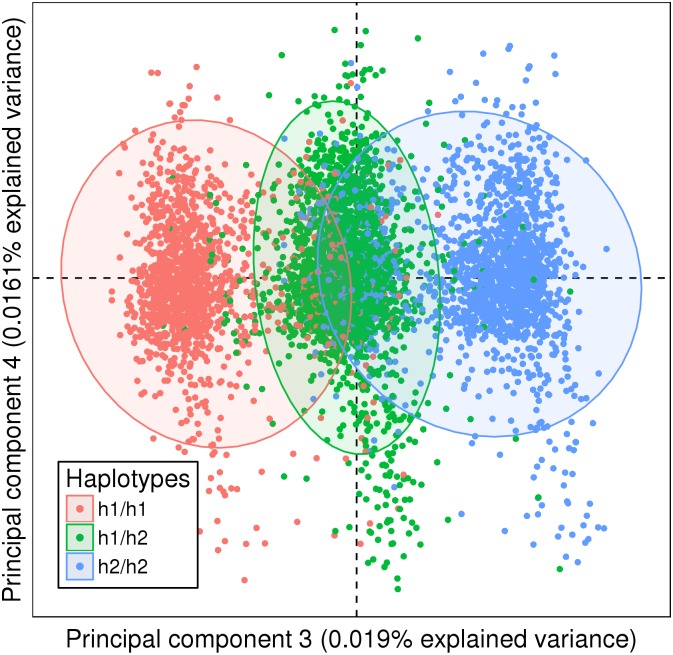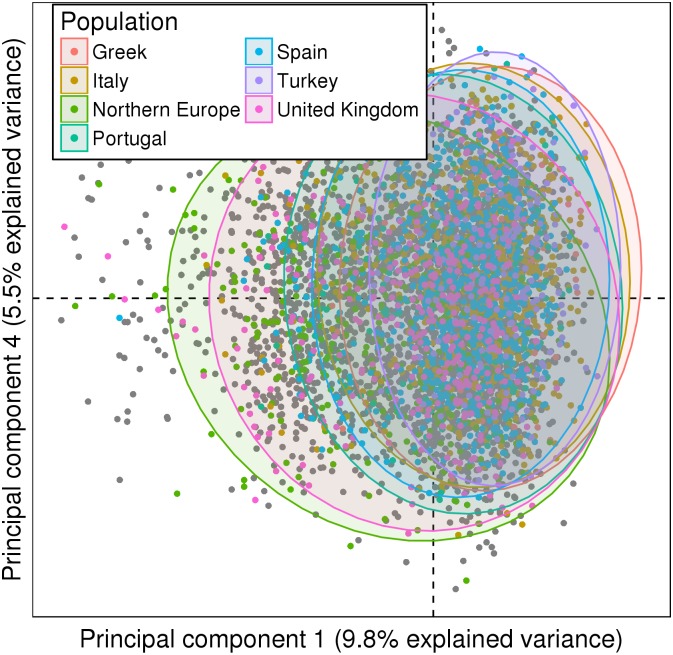Abstract
Systemic Autoimmune Diseases, a group of chronic inflammatory conditions, have variable symptoms and difficult diagnosis. In order to reclassify them based on genetic markers rather than clinical criteria, we performed clustering of Single Nucleotide Polymorphisms. However naive approaches tend to group patients primarily by their geographic origin. To reduce this “ancestry signal”, we developed SNPClust, a method to select large sources of ancestry-independent genetic variations from all variations detected by Principal Component Analysis. Applied to a Systemic Lupus Erythematosus case control dataset, SNPClust successfully reduced the ancestry signal. Results were compared with association studies between the cases and controls without or with reference population stratification correction methods. SNPClust amplified the disease discriminating signal and the ratio of significant associations outside the HLA locus was greater compared to population stratification correction methods. SNPClust will enable the use of ancestry-independent genetic information in the reclassification of Systemic Autoimmune Diseases. SNPClust is available as an R package and demonstrated on the public Human Genome Diversity Project dataset at https://github.com/ThomasChln/snpclust.
Introduction
The PRECISESADS project aims at reclassifying Systemic Autoimmune Diseases (SADs), a group of chronic inflammatory conditions characterized by the presence of unspecific autoantibodies in the serum and serious clinical consequences, based on genetic and molecular biomarkers rather than clinical criteria. SADs affect 1% of the global population [1] and have limited treatment options and difficult diagnosis. The diseases studied in PRECISESADS are Systemic Lupus Erythematosus (SLE), Systemic Sclerosis, Rheumatoid Arthritis, Sjögren’s Syndrome, Primary Antiphospholipid Antibody Syndrome, and undifferentiated cases.
Several technological platforms are used to generate biomarker data from patient samples, to obtain as much information as possible about the genetic and molecular mechanisms involved. The technologies include Single Nucleotide Polymorphisms (SNPs) microarrays, which measures hundreds of thousands of common genetic variations in a population, gene expression and protein microarrays, mass spectrometry for metabolic profiling, or flow cytometry, as examples. The methodological approach is to first analyze data from each technological platform individually and then to merge relevant features from each platform to build the final classifier. Here we present the results of the preparatory work for SNP clustering analysis performed on a test dataset.
Familial and twin studies have estimated a 50% genetic component in SADs [2, 3] and Genome-Wide Association Studies (GWAS) have found several loci associated with SADs [4]. However, genome-wide clustering of SNPs is known to primarily group patients by ancestry prior to disease relevant features [5, 6]. In order to emphasize the disease relevant signal, we developed SNPClust, a clustering method to overcome this “ancestry bias” by selecting and summarizing SNPs contributing strongly to localized sources of genetic variation as detected by Principal Component Analysis (PCA) [7].
SNPClust first applied PCA to project patients on the largest sources of variance by linear combinations of SNPs. Then for each principal component, the SNPs that had significantly high contributions were selected. Many correlated SNPs were selected from specific loci due to linkage disequilibrium between SNPs, which form haplotypes, and therefore still produced an ancestry signal. To address this, for SNPs selected from the same principal component, SNPClust summarized physically close SNPs in linkage disequilibrium by one variable inferring a haplotype, and reduced the ancestry signal while conserving the other underlying genetic signals.
The test dataset contained SNP microarray data from 4,212 European SLE patients and 1,221 European controls. After quality control, Minor Allele Frequency (MAF) filtering, and tag SNP selection [8], PCA was performed on 379,190 SNPs from 5,433 patients. For each of the 100 first principal components, strong contributing SNPs were selected and SNP-dense regions were summarized by haplotypes. A total of 261 SNPs were selected and 331 haplotypes inferred.
On the SNPClust selected dataset, the clustering signal due to ancestry was significantly reduced. The performance of SNPClust was compared to GWAS standard approaches and reference population substructure correction methods [9, 10]. SNPClust was shown to enrich the selection of ancestry-independent sources of genetic variation associated with the phenotype, and hence propose more robust candidate biomarkers.
Results
Ancestry clusters
As expected, PCA applied on the input dataset (without any prior feature selection or data transformation) grouped patients by the country of origin of the samples, discriminating Northern from Southern Europeans in the first principal component and Eastern from Western Europeans in the second (Fig 1).
Fig 1. Initial grouping of genetic data.
Two first principal components of the PCA on 379,190 SNPs from 5,433 European SLE patients and controls with 95% confidence ellipses. Northern and Southern Europeans were discriminated in the first principal component. Eastern and Western Europeans were discriminated in the second. 2,733 individuals (50%) did not have geographic information and were colored in gray.
This ancestry signal can also be seen in most of the 10 first principal components. The most important non-ancestry-based source of genetic variation in the PCA appeared on principal component 3 (see below), thus confirming that the ancestry signal is much stronger than clinically relevant signals in clustering approaches.
Selection of strong contributors
The analysis of the contributions of SNP markers to the PCA principal component axes revealed that the first twenty principal components were driven by large localized SNP groups. The chromosome 6 HLA locus was the strongest and largest contributor in all of the first 8 principal components except principal component 3. Principal component 3 was driven by the chromosome 8 locus 8p23, one of the largest inversion polymorphism encompassing 4,500,000 base pairs and including the SLE associated gene BLK [11] (Fig 2). As 8p23 was a main contributor in some of the first principal components, we confirmed that ancestry-independent signals can be extracted by SNPClust.
Fig 2. Selection of strong SNP contributors.
(a) The 2,000 most contributing SNPs to each of the first 8 principal components are displayed by chromosomal position and colored by chromosomes. Principal components were driven by large localized SNP groups and the chromosome 6 locus HLA was the strongest and largest contributor in all of the first 8 principal components, except principal component 5. (b) Selection of SNPs by the Gaussian mixtures based method. Selected SNPs are colored in red. SNPs are displayed on the x-axis by rank of chromosomic position, i.e. SNPs are regularly spaced and ordered by chromosome and position.
The 100 first principal components, on which the Gaussian mixture models based selection was applied, explained 3.5% of the total variance. Large localized SNP groups were selected along with other strong contributors. In total, 10,422 SNPs were selected, including 4,090 SNPs from the first 8 principal components (Fig 2).
Haplotype summarization
Then, the 10,422 selected SNPs were reduced to 261 SNPs and 331 haplotypes by the haplotype estimation process described in the methods. For example, on principal component 3, the 875 SNPs from chromosome 8 were summarized by 2 distinct haplotypes h1 and h2. Each subject was assigned a h1/h1, h1/h2, or h2/h2 haplotype combination for this region (Fig 3).
Fig 3. Haplotype summarization of the 8p23 locus.
The haplotypes estimated from the 875 selected SNPs from chromosome 8 were best fitted by two groups. The resulting three groups, plotted with 95% confidence ellipses, accurately represented the three clusters in principal component 3 and showed that haplotypes preserved information carried by SNPs.
Ancestry signal reduction
We applied PCA on the selected SNPs and haplotypes. The first principal components did not cluster patients neither by phenotype nor by centers (Fig 4).
Fig 4. PCA after SNPClust application.
First principal components of the PCA on the 261 SNPs and 331 haplotypes from 5,433 patients, with 95% confidence ellipses. The principal components did not discriminate SLE patients from controls.
The method therefore reduced the ancestry signal and produced a set of features that could be further investigated for disease relevant signals.
Benchmark
GWAS have found several loci associated with SADs. However such approaches are impaired by population substructures that can generate false-positives or domestic association signals [4]. In order to evaluate the information conserved by SNPClust and compare it to existing population stratification correction methods, a GWAS was performed on the input dataset, without or with subpopulation structure correction (see methods), and compared with the results of a GWAS performed on the SNPClust selected dataset.
Compared with the GWAS performed directly on the input dataset, the GWAS performed on the SNPClust-processed dataset selected much less SNPs with a nominal p-value < 0.05: 97,066 vs. 222. In addition, the initial selection of SNPs by SNPClust reduced the impact of the multiple testing correction: 59% of SNPs on the input dataset with p < 0.05 had a False Discovery Rate (FDR) [12] > 5%, compared to only 30% after SNPClust (Table 1).
Table 1. Performances of feature selection methods.
Associations of the input dataset without or with population stratification correction by genomic control and Eigenstrat (with 5 and 10 principal components considered) compared with SNPClust.
| Feature selection method | Number of p-values < 5% | Number of FDR q-values < 5% | Number of FDR q-values in HLA < 5% |
|---|---|---|---|
| (none) | 97,066 | 39,555 | 951 |
| Genomic control | 18,267 | 271 | 232 |
| Eigenstrat 5 | 22,605 | 117 | 64 |
| Eigenstrat 10 | 15,269 | 28 | 9 |
| SNPClust | 222 | 156 | 38 |
Compared with GWAS with genomic control [9], SNPClust produced 42% less significant associations after multiple testing correction, but 3 times more outside the HLA region. Therefore SNPClust has less statistical power than genomic control but is much more effective in finding associations from several loci. Eigenstrat [10] was performed with 5 and 10 principal components. In both cases, SNPClust had more statistical power, with less hits in HLA (24% vs. 55% and 32%).
Increasing statistical power can increase false positive rate. However SLE has still a large unexplained heritability and increasing the power is a possible step to reduce it by discovering novel markers. Additionally, the FDR multiple testing correction method can also be more stringent to reduce the power and the false positive rate.
The HLA locus exhibited a pitfall of GWAS with multiple testing correction: even after TagSNP selection, most associated SNPs were from few loci, due to haplotypes. This had the effect of excluding other loci when multiple testing correction was applied. SNPClust overcame this by summarizing the SNPs from one locus in one haplotype. Associated genes found by SNPClust and Eigenstrat with 5 components were compared. SNPClust had 67 unique genes associated, Eigenstrat had 37, and with an intersection of 1. The associated genes were also compared to previously known genes associated with SADs. The intersection had 1 known gene (NOTCH4). Excluding this one, SNPClust had 4 known genes (MICA, MSH, PSORS1C1, RAD51B) and Eigenstrat 4 (ATG5, BANK1, STAT4, TNXB).
Discussion
The ancestry information is contained in many SNPs across the genome, and may therefore be present in clinically relevant SNPs, in particular in auto-immune diseases where the HLA locus is involved. Therefore removing simply the main known ancestry-informative markers may lead to the removal of clinically relevant SNPs while preserving many SNPs carrying small bits of ancestry information. Approaches considering the first principal components to adjust associations [10] can also result in loss of clinically relevant information because not all the first principal components are associated with ancestry.
SNPClust overcomes these limitations in two steps. First the major contributors to a large number of the first principal components are considered, therefore selecting the markers explaining most of the variance in the dataset. This has the property of preserving the largest sources of genetic variation. Then, the SNPs that could be considered as haplotypes due to their correlation and spatial proximity are summarized. This reduces the relative importance of ancestry information present in many SNPs while preserving the information conveyed by the haplotypes. At the same time, it also reduces the multiple-testing problem.
In the dataset of 379,190 SNPs from SLE patients and controls, the first principal components were associated with ancestry. After application of SNPClust 592 markers remained and the first principal components were not associated to the centers. Therefore the ancestry information and the number of markers were strongly reduced.
This method is also interesting for GWAS, due to the enrichment of ancestry-independent markers tested and the reduced multiple testing problem. When compared to genomic control, 42% less SNPs were associated with the diseases but 10 times more outside the HLA locus. Compared to Eigenstrat, SNPClust had more statistical power and a higher ratio of associations outside HLA. Therefore SNPClust is useful to find several associated loci without being overwhelmed by strong signals from one single locus such as HLA.
SNPClust will be applied to the SNP array data generated in the PRECISESADS project and will possibly enable the use of ancestry-independent genetic information in the reclassification of SADs. It is available as an R package and demonstrated on the public Human Genome Diversity Project dataset [6] at https://github.com/ThomasChln/snpclust.
Materials and Methods
Input dataset
The dataset contained 4,212 European SLE patients and 1,221 European healthy controls. It was previously published [13] and approved by ethics committees. No samples were used and records were de-identified. The files were binary PLINK files [14]. They were converted in the Genomic Data Structure format [15].
Analysis set
Observations with missing value rates above 3% and SNPs with missing value rates above 1% were excluded. An additive genetic model is then used (AA = 0, AB = 1, BB = 2) and SNPs with MAF below 5% were excluded to remove rare variants, which are more prone to genotyping errors. In addition, in order to decrease the required computation time and memory usage, redundant SNPs were removed by applying TagSNP (r2 > 0.8, window of 500,000 base pairs). The missing values were imputed by random sampling of each SNP. Then each SNP was centered and scaled to unit variance.
A total of 5,433 patients and 379,190 SNPs were selected for analysis. This dataset defines our analysis set.
SNPClust
Selection of strong contributors to principal components
PCA was applied on the analysis set. PCA is a dimensionality reduction method, which projects SNPs by linear combination to maximize the variance on successive axes, i.e. principal components, while constraining the axes to be orthogonal. SNPs with large absolute projection values, i.e. loadings or contributions, to the 100 first principal components were selected.
For each principal component, a Gaussian mixture model [16] with 2 mixture components was fitted to the absolute values of SNP contributions. Only the 3,000 highest absolute contributions were considered for computational performance. In Gaussian mixtures, SNPs have a probability of being assigned to each Gaussian model, from which can be derived a classification uncertainty. Only the strong contributors have null uncertainty, therefore SNPs with a null classification uncertainty were selected. If SNPs were selected from more than 8 chromosomes, the model was fitted with an additional mixture until the condition was satisfied. If the condition was not satisfied after 4 iterations, i.e. with 5 mixtures, no SNPs were selected from that principal component (Algorithm 1).
Algorithm 1 Selection of strong contributors
1: Input: PCA rotation matrix i.e. SNPs coefficients to principal components
2: for coefficients in coefficientsPC1, …, coefficientsPC100 do
3: coefficients ← 3,000 highest absolute values of coefficients
4: selection ← ∅
5: for nmixtures in 2, 3, 4, 5 do
6: GMM ← Gaussian mixture model of nmixtures components on coefficients
7: selection ← coefficients with null uncertainty classification in GMM
8: if Number of chromosomes in selection < = 8 then
9: exit for loop
10: end if
11: end for
12: store selection in output
13: end for
14: Output: selectionPC1, …, selectionPC100
Haplotype summarization
In a second step, in order to summarize large loci, for each principal component, selected SNPs on a same chromosome and closer than 1,000,000 base pairs away were summarized by haplotypes, pairs of binary values. Haplotypes were inferred with the SHAPEIT software [17] which uses hidden Markov models and has linear complexity with the number of SNPs. Haplotypes were then grouped in 2 classes by Gaussian mixture models. Correlated haplotypes were removed when they were on the same chromosome and the squared correlation was above 0.8 (Algorithm 2).
Algorithm 2 Summarization of physically close SNPs
1: Input: Selected SNPs for the 100 first principal components
2: haplotypes ← ∅
3: for SNPs in selectionPC1, …, selectionPC100 do
4: for locus in groups of SNPs closer than 1,000,000 base pairs in SNPs do
5: haplotype ← Haplotype estimation of locus
6: SNPs ← Exclude locus from SNPs
7: store haplotype in haplotypes
8: end for
9: end for
10: for haplotypes in groups of haplotypes from same chromosome do
11: haplotypes ← Squared correlation threshold of 0.8 on haplotypes
12: end for
13: Output: Union of haplotypes and SNPs
Benchmark
To evaluate the SNPClust algorithm, we performed a GWAS on the SNPClust selected dataset and on the input dataset with and without population stratification correction. First, a generalized linear model with a binomial error distribution was fitted to each SNP and haplotype to predict the disease of patients. Type 2 Analysis of Variance was then applied to obtain p-values.
Multiple testing correction was performed with FDR, and results were compared with the outcome of our method. Then, two population stratification correction methods were tested, genomic control and Eigenstrat.
Data Availability
Data are available from the Genyo and CSIC institutions for researchers who meet the criteria for access to confidential data. Access to data can be requested to Dr. Marta Alarcòn- Riquelme (marta.alarcon@genyo.es).
Funding Statement
Quartz Bio S.A. provided support in the form of salaries for TC, ADC, and JW, but did not have any additional role in the study design, data collection and analysis, decision to publish, or preparation of the manuscript. This work has received support from the EU/EFPIA/ Innovative Medicines Initiative Joint Undertaking PRECISESADS grant no. 115565.
References
- 1. Cooper GS, Bynum ML, Somers EC. Recent insights in the epidemiology of autoimmune diseases: improved prevalence estimates and understanding of clustering of diseases. Journal of autoimmunity. 2009;33(3):197–207. 10.1016/j.jaut.2009.09.008 [DOI] [PMC free article] [PubMed] [Google Scholar]
- 2. Cooper GS, Miller FW, Pandey JP. The role of genetic factors in autoimmune disease: implications for environmental research. Environmental Health Perspectives. 1999;107(Suppl 5):693 10.2307/3434329 [DOI] [PMC free article] [PubMed] [Google Scholar]
- 3. Bax M, van Heemst J, Huizinga TW, Toes RE. Genetics of rheumatoid arthritis: what have we learned? Immunogenetics. 2011;63(8):459–466. 10.1007/s00251-011-0528-6 [DOI] [PMC free article] [PubMed] [Google Scholar]
- 4. Delgado-Vega A, Sánchez E, Löfgren S, Castillejo-López C, Alarcón-Riquelme ME. Recent findings on genetics of systemic autoimmune diseases. Current opinion in immunology. 2010;22(6):698–705. 10.1016/j.coi.2010.09.002 [DOI] [PMC free article] [PubMed] [Google Scholar]
- 5. Novembre J, Johnson T, Bryc K, Kutalik Z, Boyko AR, Auton A, et al. Genes mirror geography within Europe. Nature. 2008;456(7218):98–101. 10.1038/nature07331 [DOI] [PMC free article] [PubMed] [Google Scholar]
- 6. Li JZ, Absher DM, Tang H, Southwick AM, Casto AM, Ramachandran S, et al. Worldwide human relationships inferred from genome-wide patterns of variation. science. 2008;319(5866):1100–1104. 10.1126/science.1153717 [DOI] [PubMed] [Google Scholar]
- 7. Patterson N, Price AL, Reich D. Population Structure and Eigenanalysis. PLoS Genet. 2006;2(12):e190 10.1371/journal.pgen.0020190 [DOI] [PMC free article] [PubMed] [Google Scholar]
- 8. Stram DO. Tag SNP selection for association studies. Genetic epidemiology. 2004;27(4):365–374. 10.1002/gepi.20028 [DOI] [PubMed] [Google Scholar]
- 9. Devlin B, Roeder K. Genomic control for association studies. Biometrics. 1999;55(4):997–1004. [DOI] [PubMed] [Google Scholar]
- 10. Price AL, Patterson NJ, Plenge RM, Weinblatt ME, Shadick NA, Reich D. Principal components analysis corrects for stratification in genome-wide association studies. Nature genetics. 2006;38(8):904–909. 10.1038/ng1847 [DOI] [PubMed] [Google Scholar]
- 11. Namjou B, Ni Y, Harley IT, Chepelev I, Cobb B, Kottyan LC, et al. The Effect of Inversion at 8p23 on BLK Association with Lupus in Caucasian Population. PloS one. 2014;9(12):e115614 10.1371/journal.pone.0115614 [DOI] [PMC free article] [PubMed] [Google Scholar]
- 12. Benjamini Y, Hochberg Y. Controlling the false discovery rate: a practical and powerful approach to multiple testing. Journal of the Royal Statistical Society Series B (Methodological). 1995; p. 289–300. [Google Scholar]
- 13. Bentham J, Morris DL, Graham DSC, Pinder CL, Tombleson P, Behrens TW, et al. Genetic association analyses implicate aberrant regulation of innate and adaptive immunity genes in the pathogenesis of systemic lupus erythematosus. Nature genetics. 2015;. [DOI] [PMC free article] [PubMed] [Google Scholar]
- 14. Purcell S, Neale B, Todd-Brown K, Thomas L, Ferreira MA, Bender D, et al. PLINK: a tool set for whole-genome association and population-based linkage analyses. The American Journal of Human Genetics. 2007;81(3):559–575. 10.1086/519795 [DOI] [PMC free article] [PubMed] [Google Scholar]
- 15. Zheng X, Levine D, Shen J, Gogarten S, Laurie C, Weir B. A High-performance Computing Toolset for Relatedness and Principal Component Analysis of SNP Data. Bioinformatics. 2012;28(24):3326–3328. 10.1093/bioinformatics/bts606 [DOI] [PMC free article] [PubMed] [Google Scholar]
- 16. Fraley C, Raftery AE. Model-based Clustering, Discriminant Analysis and Density Estimation. Journal of the American Statistical Association. 2002;97:611–631. 10.1198/016214502760047131 [DOI] [Google Scholar]
- 17. Delaneau O, Zagury JF, Marchini J. Improved whole-chromosome phasing for disease and population genetic studies. Nature methods. 2013;10(1):5–6. 10.1038/nmeth.2307 [DOI] [PubMed] [Google Scholar]
Associated Data
This section collects any data citations, data availability statements, or supplementary materials included in this article.
Data Availability Statement
Data are available from the Genyo and CSIC institutions for researchers who meet the criteria for access to confidential data. Access to data can be requested to Dr. Marta Alarcòn- Riquelme (marta.alarcon@genyo.es).






